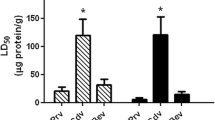Abstract
Chemical analysis of the venom of the myrmicine antMegalomyrmex foreli from Costa Rica revealed the presence of four major alkaloidal components. Two of these, 2-butyl-5-(E, 1-heptenyl)-5-pyrroline (3) and 2-butyl-5-(E, E, 1,3-heptadienyl)-5-pyrroline (4), constitute a new functional class of ant venom alkaloids, whose structures were assigned from their spectral and chemical behavior and unambiguous syntheses. The function of these compounds is suggested by field observations of the behavior ofM. foreli, its sting morphology, and the relative toxicity of 3 and 4 against termite workers.
Similar content being viewed by others
References
Beattie, A.J., 1985. The Evolutionary Ecology of Ant-Plant Mutualisms. Cambridge University Press, Cambridge.
Blum, M.S., Jones, T.H., Hölldobler, B., Fales, H.M., andJaouni, T. 1980. Alkaloidal venom mace: Offensive use by a thief ant.Naturwissenschaften. 67:144–145.
Braekman, J.C., Daloze, D., Pasteels, J.M., van Hecke, P., Declercq, J.P., Sinnwell, V., andFrancke, W. 1987. Tetraponerine-8, an alkaloidal contact poison in a Neoguinean pseudomyrmecine ant,Tetraponera sp. Z. Naturforsch. 42c:627–630.
Brandao, C.R.F. 1987. Queenlessness inMegalomyrmex (Formicidae: Myrmicinae) with a discussion of the effects of the loss of true queens in ants, pp. 111–1112,in J. Eder and H. Rembold (eds.).Chemistry and Biology of Social Insects. Proc. 10th IUSSI, Munich 1986, Verlag J. Peperny, Munich.
Brandao, C.R.F. 1990. Systematic revision of the neotropical ant genusMegalomyrmex Forel (Hymenoptera: Formicidae: Myrmicinae).Arquivos de Zoologica 31:411–481.
DeVries, P.J. 1991a. Detecting and recording the calls produced by butterfly caterpillars and ants.J. Lep. Res. In press.
DeVries, P.J. 1991b. Mutualism betweenThisbe irenea larvae and ants, and the role of ant ecology in the evolution of myrmecophilous butterflies.Biol. J. Linn. Soc. 43:178–195.
DeVries, P.J., andBaker, I., 1989. Butterfly exploitation of a plant-ant mutualism: Adding insult to herbivory.J. N.Y. Entomol. Soc. 97:332–340.
Escoubas, P., Clement, J.L., Blum, M.S., Jones, T.H., Lhommet, G., andCelerier, J.P. 1988. Toxicité des alcaloides de fourmis.Actes Coll. Insectes Sociaux. 4:51–58.
Fales, H.M., Comstock, W., andJones, T.H. 1980. Test for dehydrogenation in gas chromatography-mass spectrometry systems.Anal. Chem. 52:980–982.
Hölldobler, B., andWilson, E.O. 1990. The Ants. Harvard University Press, Cambridge.
Jones, T.H., Blum, M.S., andFales, H.M. 1982. Ant venom alkaloids fromSolenopsis andMonomorium species.Tetrahedron 38:1949–1958.
Jones, T.H., Blum, M.S., Andersen, A.N., Fales, H.M., andEscoubas, P. 1988a. Novel 2-ethyl-5-alkylpyrrolidines in the venom of an Australian ant of the genusMonomorium.J. Chem. Ecol. 14:35–45.
Jones, T.H., Stahly, S.M., Don, A.W., andBlum, M.S. 1988b. Chemotaxonomic implications of the venom chemistry of someMonomorium “antarcticum” populations.J. Chem. Ecol. 14:2197–2212.
Jones, T.H., Blum, M.S., Escoubas, P., andMusthak Ali, T.M. 1989. Novel pyrrolidines in the venom of the antMonomorium indicum.J. Natl. Prod. 52:779–784.
Jones, T.H., Blum, M.S., Fales, H.M., Brandao, C.R.F., andLattke, J. 1991. Chemistry of venom alkaloids in the ant genusMegalomyrmex.J. Chem. Ecol. 17:1897–1908.
Kugler, C. 1979. Evolution of the sting apparatus in the myrmicine ants.Evolution 33:117–130.
Miyakoshi, T. 1986. A convenient synthesis of 4-oxoalkanals.Synthesis 1986:766–768.
Obin, M.S., andVander Meer, R.K., 1985. Gaster flagging by fire ants (Solenopsis spp.): Functional significance of venom dispersal behavior.J. Chem. Ecol. 11:1757–1768.
Pedder, D.J., Fales, H.M., Jaouni, T., Blum, M.S., MacConnell, J., andCrewe, R.M. 1976. Constituents of the venom of a South African fire ant (Solenopsis punctaticeps).Tetrahedron. 32:2275–2279.
Pierce, N.E. 1987. The evolution and biogeography of associations between lycaenid butterflies and ants.Oxford Surveys Evolutionary Biol. 4:89–116.
Prestwich, G.D., andCollins, M.S. 1982. Chemical defense secretions of the termite soldiers ofAcorhinotermes andRhinotermes (Isoptera: Rhinoterminae).J. Chem. Ecol. 8:147–161.
Prestwich, G.D.,Kaib, M.,Wood, W.F., andMeinwald, J. 1975. 1,13-Tetradecadien-3-one and homologs: New natural products isolated fromSchedorhinotermes soldiers.Tetrahedron Lett. 4701–4704.
Prestwich, G.D., Graham, S. McG., Handley, M., Latli, B., Streinz, L., andTasayco, J.M.L. 1989. Enzymatic processing of pheromones and pheromone analogs.Experientia 45:263–270.
Quennedey, A., Brule, G., Rigaud, J., Dubois, P., andBrossut, R. 1973. La glande frontale des soldats deShedorhinotermes putorius (Isoptera): Analyse chimique et fonctionnement.Insect Biochem. 3:67–74.
Spanton, S.G., andPrestwich, G.D. 1981. Chemical self-defense by termite workers: Prevention of autotoxication in two rhinotermitids.Science 214:1363–1365.
Tasayco, J.M.L. andPrestwich, G.D. 1990a. Aldehyde-oxidizing enzymes in an adult moth:In vitro study of aldehyde metabolism inHeliothis virescens.Arch. Biochem. Biophys. 278:444–451.
Tasayco, J., M.L., andPrestwich, G.D. 1990b. A specific affinity reagent to distinguish aldehyde dehydrogenases and oxidases.J. Biol. Chem. 265:3094–3101.
Way, M.J. 1963. Mutualism between ants and honeydew producing Homoptera.Annu. Rev. Entomol. 8:307–344.
Author information
Authors and Affiliations
Rights and permissions
About this article
Cite this article
Jones, T.H., DeVries, P.J. & Escoubas, P. Chemistry of venom alkaloids in the antMegalomyrmex foreli (Myrmicinae) from Costa Rica. J Chem Ecol 17, 2507–2518 (1991). https://doi.org/10.1007/BF00994598
Received:
Accepted:
Issue Date:
DOI: https://doi.org/10.1007/BF00994598




